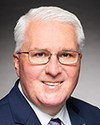Madam Speaker, our government is deeply disappointed by GM's announcement regarding its global restructuring, which will affect its plant in Oshawa.
This decision will affect not only their operations and their workers here in Canada, but also in the U.S. and around the world. This is terrible news for the women and men whose jobs will be affected, for their families, and for the community.
I want to thank my colleague from Durham for his remarks. I am looking forward to the opportunity to highlight some of the key aspects he raised. I also want to acknowledge the member for Whitby, who spoke so eloquently about the impact this is having on her constituency, for the great advocacy work she has done to promote the automotive sector.
As mentioned, today is a very sad day, disappointing, to say the least, and devastating for the community of Oshawa and the workers and their families. Our government understands that this is a very difficult time for the region and the workers but also for the suppliers and so many people who are indirectly impacted by this news. The company officials highlighted that this was a decision that was not specifically targeted at Oshawa. They indicated that this was part of their global restructuring initiative. However, from our perspective, this is not a good day for Oshawa. This is not a good day for our auto workers.
I have a personal connection to this particular sector. I started my career in the automotive sector. My first co-op job was with the Ford Motor Company of Canada. I really started to understand how important this sector was in terms of the impact it had on the community. I was very fortunate that after my placement at Ford Motor Company, I was offered a full-time job in Oakville, very near to where I now live and where I represent Mississauga—Malton. I had the opportunity to meet with the dealers and see the outreach work they did to promote a sense of community by supporting the local soccer club or swim team or by helping out through volunteering or providing donations. That is an example of the impact the automotive sector has, not only because of the manufacturing or the sales and marketing aspects but because of the dealerships that are on the front line with consumers.
We are very fortunate in Canada. We have a very strong and vibrant automotive sector, a very strong and robust dealership sector. We have over two million vehicles produced on an annual basis, and that really speaks to a vibrant automotive sector. I saw that as a student when I was in Windsor. I did my MBA there, and I recall looking at the Ambassador Bridge and the number of trucks that would cross that bridge with car parts. On average, we have been told, car parts cross that bridge seven or eight times. That speaks to the integrated supply chain and the impact the automotive sector had in Windsor and Detroit and the surrounding region. This is a sector that is very important to me.
Now as the member of Parliament for Mississauga—Malton, I deal with many suppliers who provide logistical support and parts support to the major auto makers, particularly to the auto manufacturing facilities at Ford in Oakville but also to those in Oshawa, Cambridge and other parts of Ontario.
I have heard directly from my constituents and from Canadians how devastated they were to hear this news when some of it started to break last night and when it was officially confirmed by General Motors today. I want to very quickly highlight that all is not doom and gloom. What happened today is of course a major setback for the community of Oshawa, but it is a resilient community, and I am confident that we will talk about a path forward momentarily.
Overall, the automotive sector in Canada employs 500,000 people. Both directly and indirectly, 500,000 Canadians are connected to the automotive sector. It contributes a significant amount to our national economy, $18 billion. It has an impact not only in Ontario or in the southwestern region or in the area I represent. It has an impact across the country. This is a significantly important sector to our economy.
As well, there are suppliers that support this sector, some 700 unique suppliers that really create a value proposition for the automotive sector. It is not only that we have a world-class workforce and an incredible supply chain, but it is also important to note that we have some of the best academic institutions supporting the work they do.
Just a few months ago, at the end of August, along with my colleague from Whitby and the Prime Minister, I was very fortunate to make an announcement at the University of Ontario Institute of Technology of a $9.5-million investment in the Automotive Centre of Excellence. That confirms how important we see UOIT as being, because of the work it does with GM and within that local community. We clearly understand how important academic institutions are. It is why we increased funding for grants and contributions in the last budget by $4 billion so that our academic institutions could have some of the world-class research that can really support this very important sector as well.
While some people wonder if the automotive sector is one that represents the past, it is important to note that it is not. This sector is so innovative and has so much technology associated with it. I remember going to the Detroit Auto Show, and it was not all about horse power. Vendors were talking about software power. It is incredible the amount of technology that is vehicles now, and we want to be part of that future and that technology.
We are very fortunate in Canada. We produce one car every 13 seconds. Think about that. We have eight plants, notwithstanding the announcement today, and we have an incredibly strong footprint as well. We also export to the U.S. and other key markets. In 2017, our export numbers were $86.5 billion. As a trading nation, we recognize that we build these vehicles not only for domestic purchases, but also to make sure that the vehicles produced here in Canada, which are of the best quality, are very competitive and are sold abroad. Significant business is done with the United States as well.
I have highlighted that we have some of the best-quality plants. I have visited many of these facilities and seen first-hand the numerous J.D. Power awards these facilities have received because of their quality workmanship. This fundamentally speaks to the fact that our number one asset, our value proposition, that distinguishes Canada and why companies invest here and why GM has such a long and proud history here in Canada is our people. It is because of our workforce. It is because of the skills the people have, their commitment to their craft, their dedication to make sure they understand and have the latest knowledge of what goes into a vehicle to make sure that we have the best quality standards globally.
This is what this discussion is about today. I want to give some context about the automotive sector, because it is really important to know that this sector is doing reasonably well, all things considered. When we formed government in 2015, we recognized that we inherited a program called the automotive innovation fund, AIF. There are tons of acronyms in government. For many people viewing this, as well as my grandmother, who was telling me she was listening to this debate, the automotive innovation fund was introduced by the previous government. However, the terms and conditions were such that the automotive sector was not using this fund. It sounded good, was very targeted, but it did not necessarily help the automotive sector.
Once we formed government in 2015, we changed the fund's terms and conditions. We looked at how to make sure that the fund actually worked to bring investments into Canada, and because of that, we have seen a great deal of success. Once we changed those terms, it really helped negotiations between unions and management in 2016. Because of this fund, and the new larger fund we ultimately created called the strategic innovation fund, which again helped the automotive sector, we were able to secure through direct partnerships—that means people who use this fund—$4.1 billion worth of investments in the automotive sector.
There are some skeptics out there who are asking if companies want to invest in Canada. We have a clear track record since we formed government of putting forward policies and programs for significant investments in the automotive sectors. Overall, $5.6 billion worth of additional investments were made in the sector in the last three years. This speaks to the fact that we have an incredible automotive sector in Canada.
I highlighted the reasons why. It is because we have an incredible workforce and an incredibly integrated supply chain. We have some of the best research coming out of our academic institutions that support the latest technology and research being done. This is really important and Canadians need to understand that. Again, today's announcement was devastating. It was very painful to watch, and when the news came out, I heard directly from many of the businesses in my riding and many of my constituents as well.
I also want to highlight that when we changed the terms of the automotive innovation fund and ultimately called it the strategic innovation fund, fundamentally what it boiled down to was more money, more resources to make sure that we compete with other jurisdictions because we are in a global race for some of these mandates. We are competing with other jurisdictions to make sure we attract investment.
Yes, we have very competitive tax rates. Yes, we have among the best workforces. Yes, we have free trade agreements, but ultimately other jurisdictions say that if companies want to invest in their state, in their community, they will provide additional tax breaks or additional support for them to do so. That is why we have a strategic innovation fund. Through this fund we have made significant investments, but let me be more specific.
Toyota, for example, invested significantly, over $1 billion dollars, which helped maintain and create 8,500 jobs, a significant footprint for the Cambridge—Woodstock community. It is very important that this investment was made.
It was the same thing with Honda. We made sure that we invested money from the strategic innovation fund and were able to secure $492 million, which helped secure 4,000 good quality middle-class jobs. These are significant jobs in those communities.
My colleague from Guelph will be speaking in a moment about Linamar. This was a significant investment made in the company of $750 million. Linamar is a Canadian company and a Canadian success story that is expanding its footprint here. It is a major automotive parts supplier. It also secured 9,500 jobs. Many new jobs are also created, in total 1,500 new jobs because of this investment.
This is how the strategic innovation fund is working. It boils down to jobs. It boils down to making sure we get investment, and that is exactly what we have seen in the automotive sector. As mentioned, this fund is important because we are competing with other jurisdictions.
Some would ask why we are investing this money, that it is corporate welfare and are we not cutting cheques? Absolutely not. We are competing with other jurisdictions. How can we turn our back on 500,000 employees? How can we turn our back on a sector that contributes $18 billion? We cannot and we will not.
That is why our Prime Minister has been very clear. We stand with the workers and with the automotive sector. We brought this fund forward so that we could compete with other jurisdictions as well
Today, we also had the opportunity to engage with our provincial counterparts. The Prime Minister spoke with Premier Ford and made it very clear that we are going to be here for the workers. Premier Ford also acknowledges that this is not a political issue where we point fingers. This is not a partisan issue. This is about our coming together. The members for Durham and Hamilton Centre have said this on several occasions. It is a great opportunity to show Canadians that we are all united with one key objective or focus, to make sure that we do everything possible for Canadian automotive manufacturing workers.
We are engaging with the province. We are going to look at all options. We are going to examine what we can do and what it can do and how we can work together to make sure that we protect our employees.
I have also had the opportunity to speak directly to Mayor Henry. It was a difficult conversation, because he talked about his own personal experience and story with the company. As mentioned by the members for Whitby and Durham, everyone is touched by this. GM has been there for over 100 years, so every family has a story to tell directly and indirectly. This is not simply about jobs alone. This has an impact on the local community and we recognize that. My message is very clear to Mayor Henry, who will become the new regional chair in the coming days: How can we work together?
Our government wants to be a partner. We have a track record of demonstrating that partnership. It is not empty rhetoric. We have put policies and programs in place to support the automotive sector. This is not old industrial policy; it is part of our innovation and skills plan. It is about how we move forward.
We have also engaged with the unions. I spoke with Jerry Dias and made it very clear that we are here to support the workers. What can we do? We have a very good working relationship with labour. We want to make sure that we provide every opportunity for our workers to succeed.
This is all hands on deck. This is about our coming together and working for this critical sector. To highlight that, we made some significant announcements in the fall economic statement. The Minister of Finance announced an additional $800 million for the strategic innovation fund. That means more money for this fund to attract more investments. That is a clear indication that we had something that was working, a highlight of those success stories. Going forward, we wanted to send a clear signal to industry that we have their back, and we wanted to send a clear signal to workers that we have their back. We wanted to send a signal that we wanted to see more research and development, more mandates, more jobs, and more investments. That was clearly demonstrated by that additional $800 million investment announced in the fall economic statement.
This is part of our overall plan. This is not a one-off initiative. This is part of our new smart industrial policy called the innovation and skills plan. This plan was officially launched as part of the 2017 budget. My parliamentary secretary knows full well that this plan really paves the path forward for how we are going to compete going forward. One of the key aspects of this plan is investing in people. The way we succeed is not just with innovation but also with skills, by investing in upscaling and re-scaling, and lifelong learning and education. That is how we differentiate ourselves. That is our value proposition. It is our people. It is Canadians. It is our workforce.
That was a key part. We also invested in research and development. Again, I talked about some of the investments, the $9.5 million invested in the University of Ontario Institute of Technology, as an example, a small but a specific example for that region. The member for Whitby was there when we made that announcement.
Of course it is all about seeing growth. We have seen record growth, 3% growth of our GDP last year. We have seen over 500,000 jobs created in the Canadian economy since 2015, when we took office. Those are full-time jobs, I might add. This is really important. We have more to do. That is what was clearly demonstrated in the fall economic statement as well in talking about our plan going forward.
I want to make it very clear that we are not done yet. When I talk about our innovation and skills plan, we have a supercluster for advanced manufacturing. This is an area of strength for us. Manufacturing is a point of pride for us. This is an area where Canada can continue to lead. We know that manufacturing represents significant growth opportunities. That is why, when we put forward this $950 million initiative, led by industry, advanced manufacturing succeeded, and many automakers are part of this supercluster initiative as well.
We have different policies and programs in place to make sure that our economy grows. We believe in the automotive sector. We know it has enormous potential. We want to continue to support this sector as well.
The bottom line is that if there is one number I can leave with the House that really encapsulates what I have been saying and why this debate is so important, why I am so glad that we supported this emergency debate, why I am so glad to see members from all political parties participating in this debate, it is the 500,000 jobs connected to the automotive sector. This is about jobs, jobs, jobs. Our government will continue to fight for good quality, middle-class jobs in the automotive sector.










